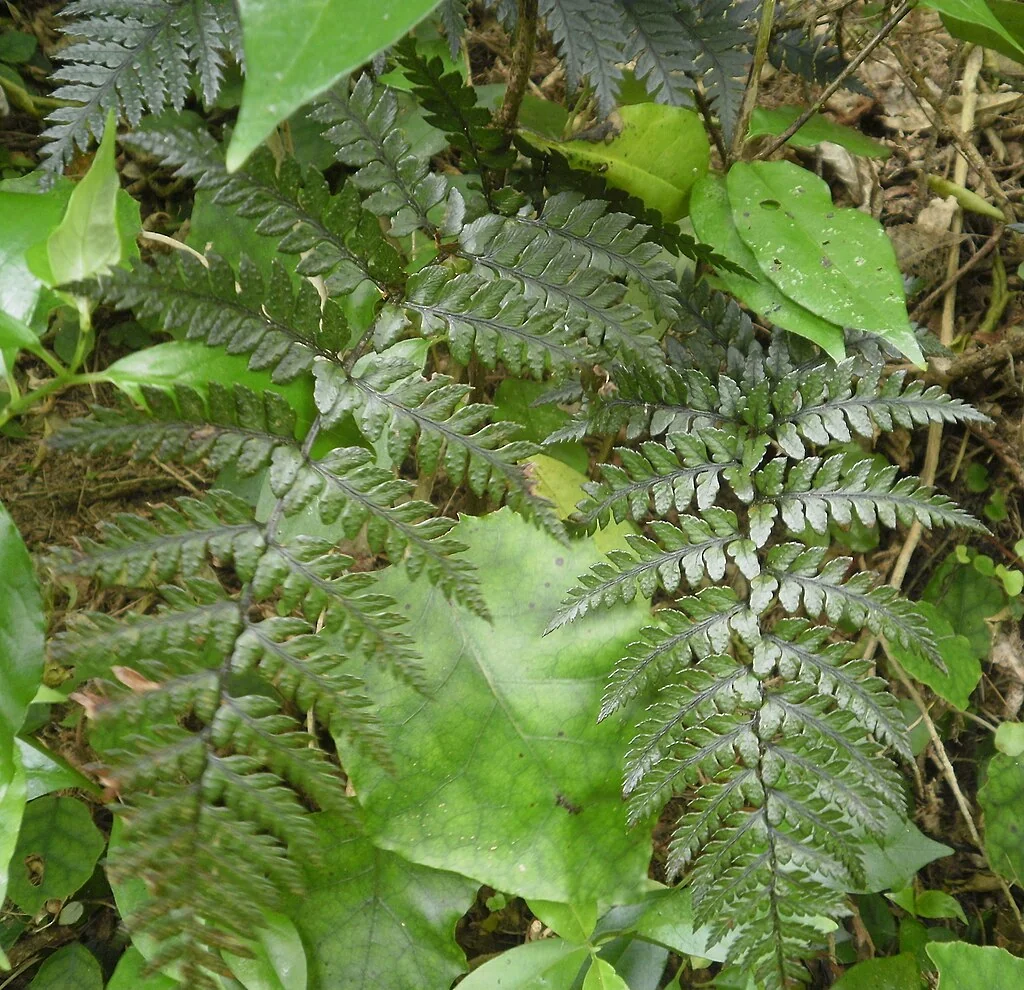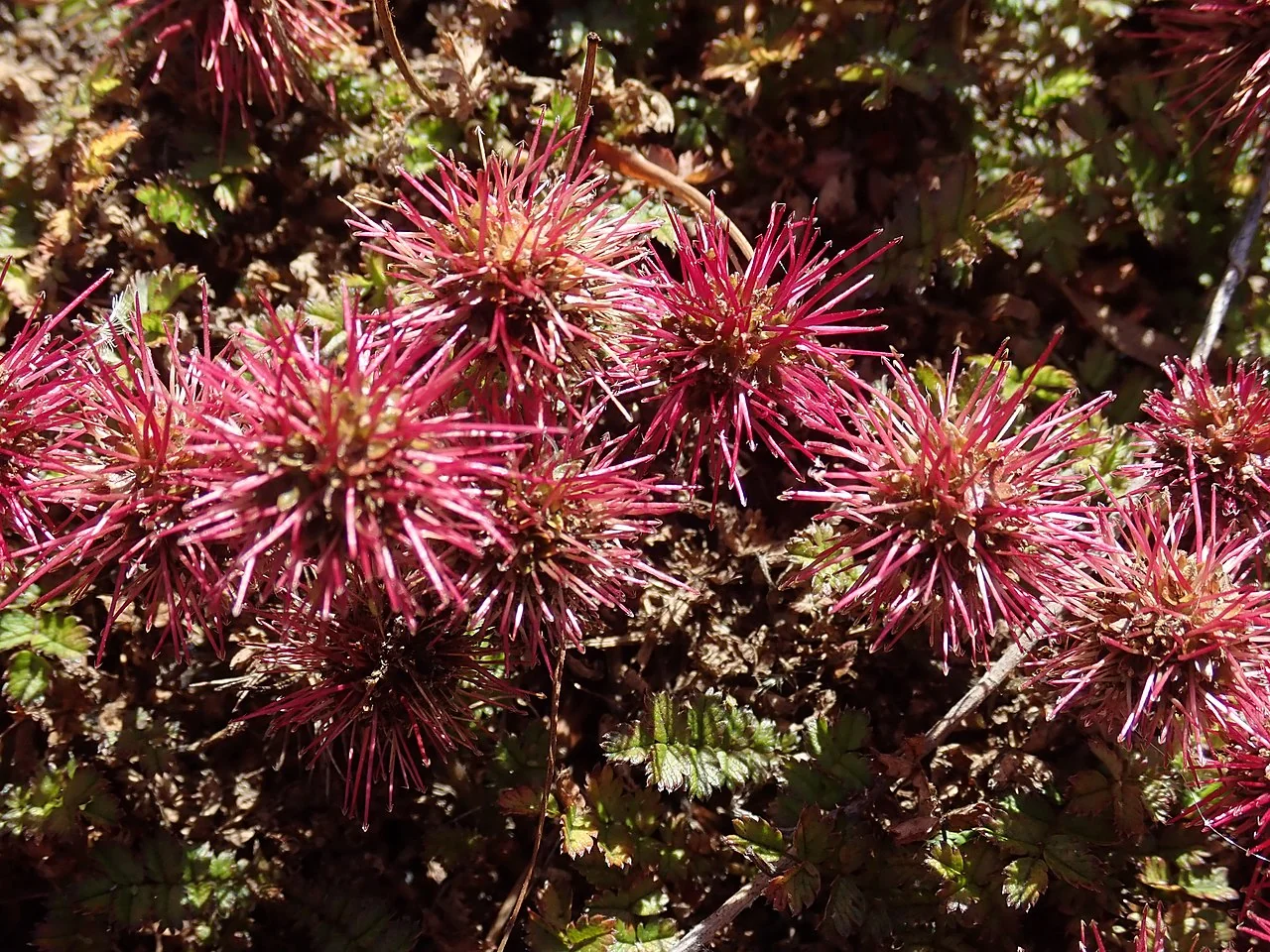
Prickly Shield Fern
Polystichum vestitum
A robust, spiny-textured shield fern of cool forests; tough and architectural in shaded borders. Learn more in our native plants guide .

Plant Description
Botanical Features
Prickly Shield Fern ( Polystichum vestitum ), also known as pānui, is a hardy, evergreen or semi-evergreen terrestrial fern native to New Zealand. It is characterized by its erect and scaly rhizome, which can sometimes form a short trunk up to 600-900 mm tall. The fronds are typically 220-1700 mm long, though some can reach up to 2250 mm, and are dark shiny green on the upper surface and paler green underneath. They are described as prickly to the touch. New fronds emerge a lighter green and are somewhat twisted. The fronds are relatively long and narrow with ± parallel sides. A distinguishing feature is the abundant covering of scales, particularly at the stipe/rachis junction. These scales are usually markedly bicolourous, with dark centers and pale margins. The spores are borne in round sori, protected by round, peltate indusia. The indusia are typically flat and concolourous, lacking dark centers.
Quick Facts
Overview
| Scientific Name | Polystichum Vestitum |
|---|---|
| Height | 0.6-1 m |
| Spread | 0.8-1.5 m |
| Light | Partial shade |
| Water Needs | Even moisture; well-drained |
| Frost | Good |
| Frost Tolerance | Very hardy; excellent frost tolerance |
| Salt Tolerance | Low; requires protection from salt exposure |
| Growth Rate | Slow to moderate |
| Lifespan | Long-lived perennial |
Climate Best Suited to
Regional climate suitability across major New Zealand cities.
Regional Suitability
| Whangārei | Ideal |
| Auckland | Ideal |
| Hamilton | Suitable |
| Rotorua | Suitable |
| Tauranga | Ideal |
| Gisborne | Ideal |
| New Plymouth | Ideal |
| Whanganui | Ideal |
| Palmerston North | Suitable |
| Napier | Ideal |
| Wellington | Ideal |
| Nelson | Ideal |
| Christchurch | Suitable |
| Dunedin | Suitable |
| Invercargill | Suitable |
| City | Climate Suitability |
|---|
Natural Habitat
Prickly Shield Fern ( Polystichum vestitum ), also known as pānui, is a hardy, evergreen or semi-evergreen terrestrial fern native to New Zealand and its subantarctic islands, including the Chatham Islands, Snares Islands, Antipodes Islands, Auckland Islands, Campbell Island, and also Macquarie Island (Australia).
Key Habitats Include:
- Coastal to Alpine Regions: Its habitat ranges from coastal areas to alpine regions. In the northern parts of its range, it is typically found in montane areas or cold situations, while further south, it extends to lower elevations.
- Forests and Scrublands: This fern thrives in various forest types, including broadleaved, podocarp, beech, and coastal forests. It can also be found under mānuka and kānuka, amongst flax, under introduced conifers and willows, in bracken and other scrub, in open grassland, and in subalpine tussock and herbfield.
- Exposed Environments: It is commonly found in exposed environments such as forest margins, gully floors, and tussock grasslands, but it can also be found within forests in colder, wetter areas of New Zealand.
Preferred Conditions:
- Soil: Polystichum vestitum prefers free-draining, fertile soil enriched with humus.
- Temperature: It can tolerate a wide range of environmental conditions, including temperatures below 0°C, especially when sheltered under a forest canopy.
- Altitude: It is found from sea level up to 1700 meters in altitude.
The Prickly Shield Fern's widespread distribution and adaptability to diverse and often harsh environments underscore its ecological importance in contributing to the biodiversity and structural complexity of New Zealand's natural landscapes.
Plant Conservation
Conservation
Polystichum vestitum , commonly known as the prickly shield fern or pūnui, is a fern species primarily found in New Zealand, where its conservation status is currently listed as "Not Threatened." However, it is considered endangered in Tasmania, Australia. This fern is endemic to New Zealand and is widely distributed across its islands, including the North and South Islands, Stewart Island/Rakiura, Chatham Islands, and several subantarctic islands. Within Australia, its presence is limited to Macquarie Island. Polystichum vestitum is adaptable, thriving in diverse habitats ranging from coastal to alpine environments, including forest margins, gully floors, and tussock grasslands. It prefers well-draining, fertile soil rich in humus and areas with higher rainfall, demonstrating tolerance to temperatures below freezing, particularly when sheltered under forest canopies. Despite its generally secure status in New Zealand, the species faces ongoing challenges. These include habitat modification, browsing by introduced mammals such as deer and possums, and competition from invasive weeds that can alter forest understory conditions. Its reliance on specific forest conditions makes it susceptible to broader ecosystem changes. Conservation efforts for Polystichum vestitum primarily focus on maintaining healthy forest ecosystems, controlling introduced pests, managing invasive species, and preserving the intricate forest conditions vital for native fern communities. The plant is also recognized for its ecological value in restoration projects and gardens.
Growing Requirements
Soil
Well-drained, moderately fertile soils; avoid prolonged waterlogging.
Light
Performs in full sun to partial shade depending on species.
Water
Keep evenly moist while establishing; reduce irrigation as roots develop.
Temperature
Hardy in most regions of Aotearoa once established.
For Prickly Shield Fern ( Polystichum vestitum ), choose a site with partial shade and soil that is well-drained, moisture-retentive. Incorporate composted organic matter to improve structure and drainage. Plant with the crown or root collar at soil level, then apply a 5-8â¯cm mulch to moderate temperature, conserve moisture, and suppress weeds. Protect young plants from extremes while establishing and consider the stated frost tolerance (seasonal) when siting near exposure or cold air drains.
Planting Guide
Best Planting Practices
Plant in cool, moist, well-drained soils in shade to part shade. Keep crowns level with the surface and mulch with leaf litter or fine bark.
- Moisture: Even moisture; avoid boggy ground.
- Soil: Rich in organic matter; add compost for poor soils.
- Spacing: 80-100 cm for mature clumps.
Ecosystem Notes
- Litter cycle: Persistent fronds add humus and protect soil.
- Habitat: Understorey shelter for fauna; nurse for seedlings.
- Associates: With tree ferns, Blechnum s.l., and podocarps.
Uses and Significance
Garden and Restoration
A robust, spiny-textured shield fern of cool forests; tough and architectural in shaded borders.
- Shaded borders
- Forest understorey
Propagate Prickly Shield Fern by division of established clumps in cool, moist conditions or by spores raised in sterile medium with bottom heat. Keep humidity high and air movement gentle to limit fungal issues while young fronds harden.
Cultural Significance
Cultural Importance
Shield Fern in Gardens
Prickly shield fern lends structure to bush garden plantings and public trails, connecting everyday horticulture with the fern-rich identity of Aotearoa.
The fern Polystichum vestitum , also known as the prickly shield fern, holds cultural significance primarily in New Zealand. It is traditionally known by the Māori names "pūniu" or "pūnui." This native plant is considered an important component of New Zealand's diverse shield ferns and represents the hardiness and adaptability of the country's indigenous flora.
Landscaping Ideas
- Architectural fronds: Bold texture for shade borders and entrances.
- Coastal shade: Handles salt-laden air if kept moist and sheltered.
- Mass planting: Dramatic effect along shaded paths and banks.
Seasonal Care Calendar
Spring
- Plant and mulch
- Protect new growth from weeds
Summer
- Deep watering in drought
- Monitor pests
Autumn
- Light formative pruning
- Top up mulch
Winter
- Plant eco-sourced stock
- Stake in windy sites
Pruning and Maintenance
Techniques and Timing
Generally minimal; formative work when young and removal of damaged wood.
Prune Prickly Shield Fern lightly to maintain structure; remove damaged shoots and avoid hard cuts on older wood.
How to Grow Prickly Shield Fern
Prickly Shield Fern ( Polystichum vestitum ) is a robust, cold-tolerant fern native to New Zealand, forming bold clumps in cool, moist, well-drained sites. This striking evergreen fern is characterized by its tough, prickly fronds, which give it a distinctive architectural quality. It is well-suited for shaded borders, woodland gardens, or as a resilient accent in exposed landscapes and forest margins. Its hardiness and unique texture make it a valuable addition to native plant collections. Understanding its propagation methods is key to successfully cultivating this beautiful native fern.
From Spores
Propagating Prickly Shield Fern from spores is a fascinating and rewarding method, though it requires patience and attention to detail. Harvest fertile fronds when the sporangia (spore cases) on the undersides of the fronds darken and are ready to release spores. Collect spores in a clean paper bag, then sow them onto the surface of a sterilized, fine, moisture-retentive medium (e.g., milled peat with fine sand or a specialized fern-raising mix). Do not cover the spores. Seal the container to maintain high humidity and place it in low light at temperatures between 18-22 °C. A green prothallus film will form in a few weeks; keep it evenly moist. When heart-shaped gametophytes develop, maintain gentle moisture until sporophytes (true ferns) appear. Carefully prick out the sporophytes into trays, grow them in shaded and humid conditions, and then pot them individually. Gradually harden them off before planting out into their final positions.
By Division
Division of established clumps is an excellent and reliable method for propagating Prickly Shield Fern, especially for home gardeners. This is best undertaken in cool, moist weather, typically in autumn or early spring. Carefully lift the entire fern clump using a spade or fork. Gently rinse the growing medium from the roots and separate the clump into firm divisions, ensuring each section has several healthy fronds and a sound rhizome (underground stem). Replant the divisions immediately at the original depth into prepared soil that is humus-rich and free-draining. Water thoroughly after replanting to settle the soil around the roots and keep the divisions evenly moist and shaded until new growth indicates successful establishment. This method is particularly effective for expanding existing plantings or for rejuvenating older, less vigorous clumps.
Pests and Diseases
Common Problems and Solutions
- Frond scorch: Protect from hot, drying winds and strong afternoon sun.
- Fungal spotting: Water at soil level; improve airflow.
- Slugs/snails: Guard emerging croziers.
Bonus Tip
Expert Growing Advice
Polystichum vestitum , also known as the Prickly Shield Fern or pūnui, is a remarkably hardy and adaptable fern native to New Zealand. It's an excellent choice for challenging New Zealand sites as it can handle exposure, frost, drought, and poor soil. Unlike many ferns that require protection, this species actually prefers more open conditions and can tolerate significant sun exposure. Its unique prickly texture makes it instantly recognizable and adds tactile interest to gardens. The name "Polystichum" comes from Greek words meaning "many rows," referring to the parallel rows of spore cases on the underside of the fronds. "Vestitum" is Latin for "to be clothed," denoting the dense cover of scales on its leaf stalks. This fern can develop short trunks up to 0.9 meters tall. Remove only the oldest, tattered fronds at winter's end to reveal new croziers without over-thinning the clump.







